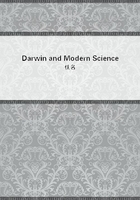
第297章
By SIR GEORGE DARWIN, K.C.B., F.R.S.
Plumian Professor of Astronomy and Experimental Philosophy in the University of Cambridge.
In ordinary speech a system of any sort is said to be stable when it cannot be upset easily, but the meaning attached to the word is usually somewhat vague. It is hardly surprising that this should be the case, when it is only within the last thirty years, and principally through the investigations of M. Poincare, that the conception of stability has, even for physicists, assumed a definiteness and clearness in which it was previously lacking. The laws which govern stability hold good in regions of the greatest diversity; they apply to the motion of planets round the sun, to the internal arrangement of those minute corpuscles of which each chemical atom is constructed, and to the forms of celestial bodies. In the present essay I shall attempt to consider the laws of stability as relating to the last case, and shall discuss the succession of shapes which may be assumed by celestial bodies in the course of their evolution. I believe further that homologous conceptions are applicable in the consideration of the transmutations of the various forms of animal and of vegetable life and in other regions of thought. Even if some of my readers should think that what I shall say on this head is fanciful, yet at least the exposition will serve to illustrate the meaning to be attached to the laws of stability in the physical universe.
I propose, therefore, to begin this essay by a sketch of the principles of stability as they are now formulated by physicists.
I.
If a slight impulse be imparted to a system in equilibrium one of two consequences must ensue; either small oscillations of the system will be started, or the disturbance will increase without limit and the arrangement of the system will be completely changed. Thus a stick may be in equilibrium either when it hangs from a peg or when it is balanced on its point. If in the first case the stick is touched it will swing to and fro, but in the second case it will topple over. The first position is a stable one, the second is unstable. But this case is too simple to illustrate all that is implied by stability, and we must consider cases of stable and of unstable motion. Imagine a satellite and its planet, and consider each of them to be of indefinitely small size, in fact particles; then the satellite revolves round its planet in an ellipse. A small disturbance imparted to the satellite will only change the ellipse to a small amount, and so the motion is said to be stable. If, on the other hand, the disturbance were to make the satellite depart from its initial elliptic orbit in ever widening circuits, the motion would be unstable. This case affords an example of stable motion, but I have adduced it principally with the object of illustrating another point not immediately connected with stability, but important to a proper comprehension of the theory of stability.
The motion of a satellite about its planet is one of revolution or rotation. When the satellite moves in an ellipse of any given degree of eccentricity, there is a certain amount of rotation in the system, technically called rotational momentum, and it is always the same at every part of the orbit. (Moment of momentum or rotational momentum is measured by the momentum of the satellite multiplied by the perpendicular from the planet on to the direction of the path of the satellite at any instant.)Now if we consider all the possible elliptic orbits of a satellite about its planet which have the same amount of "rotational momentum," we find that the major axis of the ellipse described will be different according to the amount of flattening (or the eccentricity) of the ellipse described. Afigure titled "A 'family' of elliptic orbits with constant rotational momentum" (Fig. 1) illustrates for a given planet and satellite all such orbits with constant rotational momentum, and with all the major axes in the same direction. It will be observed that there is a continuous transformation from one orbit to the next, and that the whole forms a consecutive group, called by mathematicians "a family" of orbits. In this case the rotational momentum is constant and the position of any orbit in the family is determined by the length of the major axis of the ellipse;the classification is according to the major axis, but it might have been made according to anything else which would cause the orbit to be exactly determinate.
I shall come later to the classification of all possible forms of ideal liquid stars, which have the same amount of rotational momentum, and the classification will then be made according to their densities, but the idea of orderly arrangement in a "family" is just the same.
We thus arrive at the conception of a definite type of motion, with a constant amount of rotational momentum, and a classification of all members of the family, formed by all possible motions of that type, according to the value of some measurable quantity (this will hereafter be density)which determines the motion exactly. In the particular case of the elliptic motion used for illustration the motion was stable, but other cases of motion might be adduced in which the motion would be unstable, and it would be found that classification in a family and specification by some measurable quantity would be equally applicable.